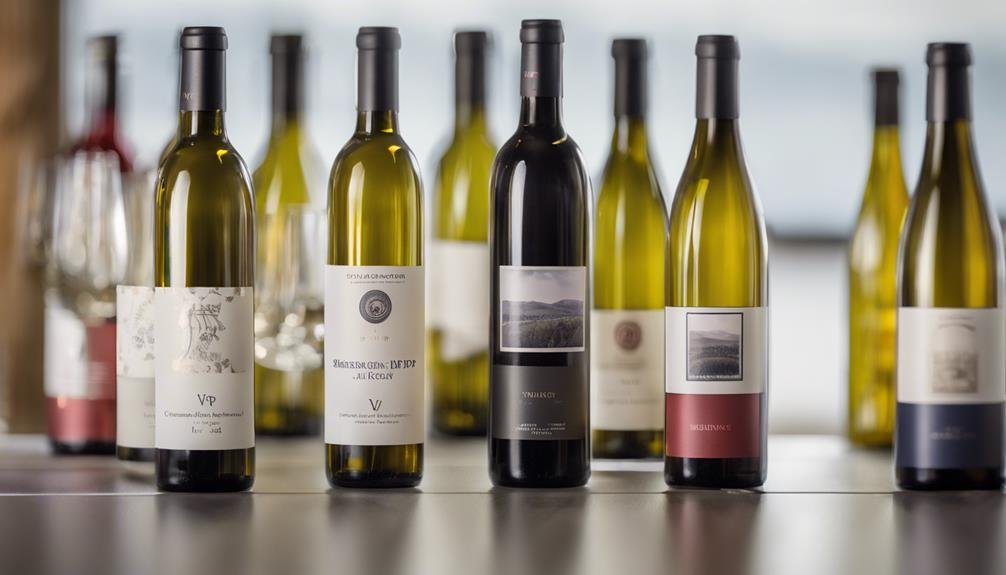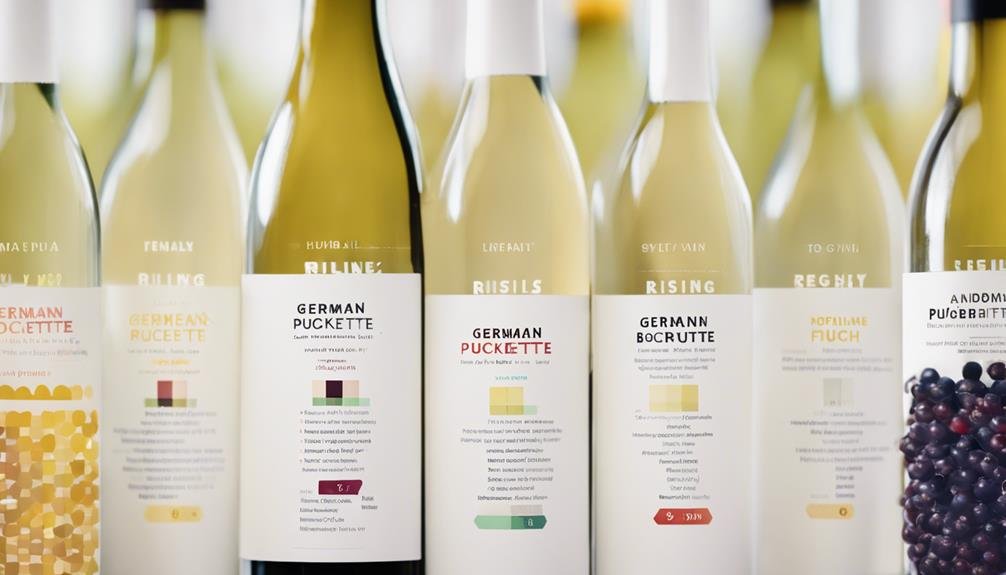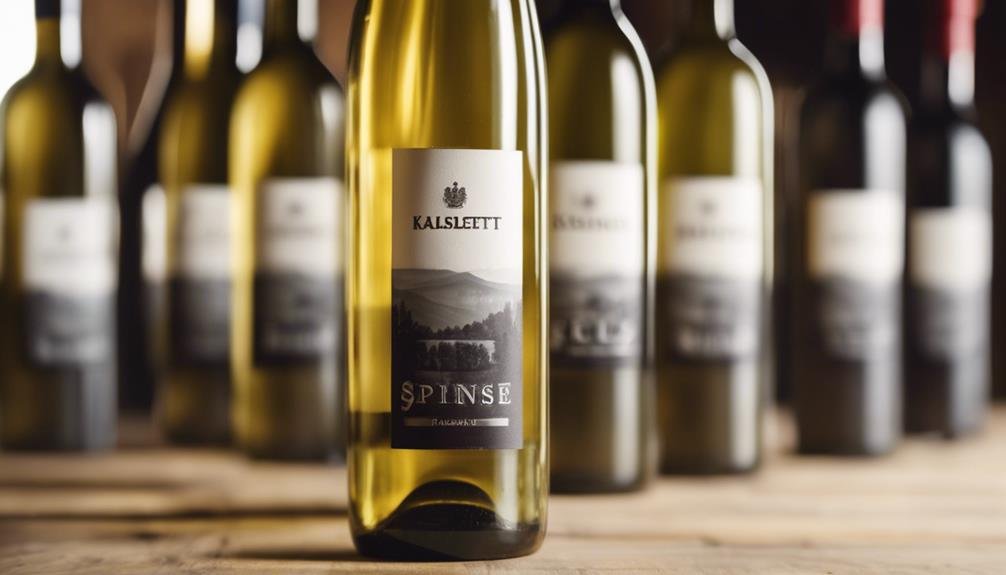Delve into the world of German Riesling quality levels, from Deutscher Wein to Prädikatswein categories. These classifications determine sweetness, grape ripeness, and regional distinctions. The system includes levels like Kabinett, Spätlese, Auslese, and more, indicating sweetness variations and grape ripeness impact. The VDP framework further refines quality, highlighting Grosse Lage/Grosses Gewächs for top regional wines. Rieslings range from dry to sweet, reflecting regional nuances. Explore the complexities of German Riesling quality tiers and the factors that shape these exceptional wines.
German Wine Quality Basics
German wine quality is governed by a structured system that incorporates various levels, from the basic Deutscher Wein to the esteemed Prädikatswein classifications. Factors like grape ripeness and regional specificity play important roles in determining quality.
The Qualitätswein category, requiring a minimum grape ripeness level, covers 13 regions, offering sweetness levels from Trocken/Selection to süß or Süss. Within the Prädikatswein classification, grape ripeness is the key determinant, with categories such as Kabinett, Spätlese, Auslese, Beerenauslese, and Trockenbeerenauslese.
Riesling wines from Mosel are traditionally sweet. Understanding these aspects provides insight into the diverse quality levels and regional nuances of German wines.
Prädikatswein Classification Details
Understanding the Prädikatswein classification in the domain of German Riesling wines provides a detailed insight into the hierarchy based on grape ripeness levels and specific categories such as Kabinett, Spätlese, Auslese, Beerenauslese, and Trockenbeerenauslese. These classifications are essential in determining the sweetness levels of the wines, ranging from light and off-dry to rich and intensely sweet. Below is a table detailing the traditional sweetness categories associated with each Prädikatswein classification:
| Prädikatswein Classification | Traditional Sweetness Category |
|---|---|
| Kabinett | Light |
| Spätlese | Off-Dry |
| Auslese | Rich |
| Beerenauslese | Intensely Sweet |
This table showcases how grape ripeness directly influences the sweetness levels of German Riesling wines, offering a clear guide for wine enthusiasts seeking specific flavor profiles.
VDP Classification Overview

The VDP classification system for Riesling wines offers a thorough framework for identifying quality levels and regional distinctions within the German wine industry. This system provides nuances in VDP classification, dividing Riesling quality into various tiers. It represents both sweet and dry styles, emphasizing additional regional classifications beyond the basic quality levels.
Significantly, the VDP Grosse Lage/Grosses Gewächs designation signifies the highest quality regional wines. Within the VDP classification, wines are categorized into Gutswein, Ortswein, and Erste Lage, each representing different levels of quality and regional specificity.
Insights on VDP and Rieslings
An in-depth exploration of the VDP classification system reveals valuable insights into the nuances of Riesling wines in Germany. The VDP's influence on Riesling styles is profound, as it was specifically created to highlight quality dry Rieslings and official varieties.
This classification represents both sweet and dry styles, offering additional regional distinctions such as Gutswein, Ortswein, and Erste Lage. Particularly notable are the VDP Grosse Lage/Grosses Gewächs designations, signifying the highest quality regional Rieslings.
This system allows for a clear differentiation between different tiers of quality, emphasizing the diverse characteristics and terroir-driven attributes of German Rieslings. Understanding the VDP's impact on Riesling wines provides enthusiasts with a deeper appreciation for the exceptional quality and diversity present in German winemaking.
Wine Folly Newsletter and Madeline Puckette

An in-depth exploration of the Wine Folly newsletter and its co-founder Madeline Puckette uncovers invaluable insights into the world of wine education. Wine Folly's newsletter serves as a valuable resource to jumpstart wine education, offering enriching content for enthusiasts at all levels.
Madeline Puckette, a James Beard Award-winning author and Wine Communicator of the Year, co-founded Wine Folly with a mission to educate about wine. Her active presence on social media platforms like Twitter (@WineFolly) enhances engagement and fosters a vibrant community of wine lovers.
Through a blend of informative articles, engaging visuals, and interactive social media presence, Wine Folly and Madeline Puckette contribute significantly to the accessibility and enjoyment of wine education for a broad audience.
Frequently Asked Questions
What Are the Key Differences Between Deutscher Wein and Landwein in Germany?
Regional differences in German wine are evident in Deutscher Wein and Landwein. Deutscher Wein adheres to stricter winemaking techniques and geographical restrictions, emphasizing quality and regional specificity. In contrast, Landwein is more lenient and allows for broader production regions.
How Does the Classification of Eiswein Differ From Other Prädikatswein Categories?
Eiswein production, a category within Prädikatswein, sets itself apart by requiring grapes to freeze on the vine, intensifying sweetness. This process results in concentrated flavors and higher sugar levels, creating a unique and sought-after dessert wine.
Are There Specific Rules for Labeling Trockenbeerenauslese Wines in Germany?
Specific regulations govern the labeling of Trockenbeerenauslese wines in Germany. These regulations guarantee that these sweet dessert wines meet strict criteria regarding grape ripeness, sugar content, and production methods. Compliance with these rules assures quality and authenticity.
What Are the Main Factors That Determine the Quality of a VDP Grosse Lage Wine?
Factors influencing the quality of a VDP Grosse Lage wine include grape selection, vineyard terroir, meticulous winemaking practices, and adherence to strict quality standards. These elements collectively contribute to producing exceptional wines of superior quality and distinction.
Can You Explain the Significance of the Erste Lage Designation Within the VDP Classification System?
Within the VDP classification system, Erste Lage holds notable significance as the premier quality level for German Riesling wines. This designation signifies top-tier vineyard sites, reflecting exceptional terroir and producing wines of unparalleled excellence.
Conclusion
To sum up, understanding the German Riesling quality levels is essential for appreciating the diverse range of wines produced in the region.
While the classification system may seem complex at first, diving into the details can enhance your enjoyment and appreciation of these renowned wines.
By exploring the nuances of grape ripeness, regional characteristics, and sweetness levels, you can truly savor the exceptional quality and unique flavors that German Rieslings have to offer.
